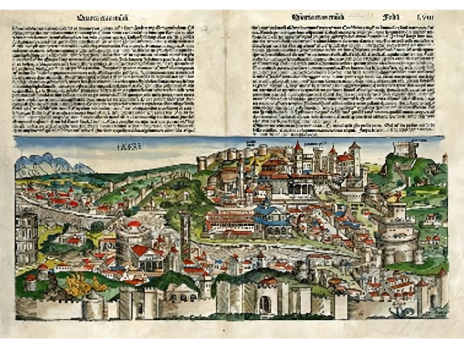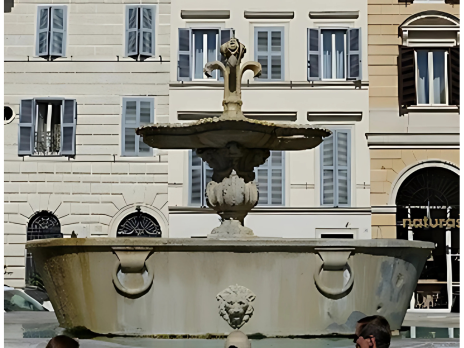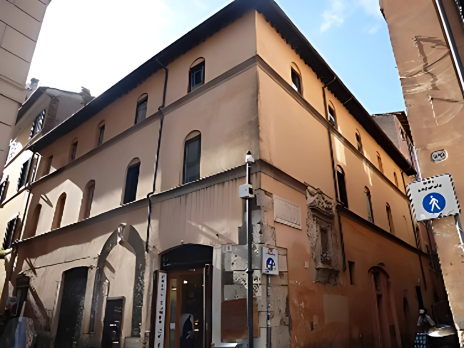
One of the City’s most memorable public squares, Piazza Farnese, with its magnificent, elegant, and serene Renaissance features, rises in the ancient “Valle” (lowland) area of the City. The Valle once accommodated Agrippa’s artificial lake (stagnum), the backdrop to the Baths and the Pantheon he constructed in the Augustan Age.

From the earliest times, Romans inhabited areas of the City close to the Fora and the hills surrounding it, far away from the plain near the bend of the Tiber River, the Campo Marzio area. Floods frequently threatened these low-lying regions, such that during the monarchical age, king Tarquinius Superbus planted them with corn.

During the Republican era, victorious generals waited here for senatorial approval for a triumphal march. It began here, proceeded through the Forum, and climbed to the Capitoline Hill. In the middle of the fifth century BC, however, buildings gradually appeared in the area: the temple of Apollo, the first public building in Campo Marzio, and later, the much larger structure, the Circus Flaminius which provided games to amuse and entertain the Plebeians.

In the early Middle Ages, the situation dramatically changed. Romans suddenly abandoned the entire Colosseum area in the 6th century AD. Ostrogothic invaders destroyed the City’s aqueduct system and cut off its water sources. Romans settled nearer the river, at its bend, to gain access to its water. Abruptly, the once uninhabited (disabitato) part of the city, virtually overnight, became inhabited (habitato), and emerged as the new center of the City.

As odd as it might seem, what visitors encounter in the City today represents virtually nothing of what had existed in the ancient part of the City, buried now by the sands (dirt and mud) of time or despoiled by the ravages wreaked upon it by those who quarried it in later centuries to construct its modern version. The Medieval City, then, not only rested atop the ancient one, but was, as well, constructed from its remains (spolia), materials stripped from former colonnades, columns, and stone fragments of many types from all over the world: granite, porphyry, and marble (giallo antico, pavonazzetto, verde antico, and others). At the beginning of the 15th century, the City, desolate and in ruins, was more an abstract concept, a quaint image, and a hazy memory of an ancient past, rather than the ‘caput mundi’ (center of the world), a status it had justifiably possessed centuries before.
Historians have created catalogues of the many magnificent structures which stood at the time of the City’s fall in 476 AD, but which virtually disappeared in the course of centuries, a partial list of which includes: fora (11), basilicas (12), temples (420), libraries (28), bath houses (11), theaters (3), amphitheaters (2), circuses (2), naumachia (5), triumphal arches (35); and equestrian statues (20). Over 4000 statues and images of the gods abounded throughout the City, all made from the most precious materials: gold, bronze, ivory, marble imported from distant lands throughout the empire. Only meager fragments remain of what once was the greatest City in the world. In 420 AD, as St. Jerome lay dying in Jerusalem, he expressed disappointment over three unfulfilled wishes: to see the face of Christ, to hear St. Paul preach, and to see the City in its full glory. Partially has his wish come true in the form of a modern replica, the Plastico, of the 4th century City created in the 1930’s by Italo Gismondo. Mussolini’s Museo della Civilta Romana in EUR houses this large-scale model whose base is sixty six by sixty six feet. Despite the complexity of the City’s layout, visitors can quickly orient themselves through several, readily visible, fixed points: the Colosseum, Pantheon, Forum, Circus Maximus and Hadrian’s Mausoleum.

What the contemporary visitor does see, however, is a City whose visible and medieval foundations gradually emerged during the Middle Ages in the uninhabited area of the ‘bend of the Tiber River’. The later development of the City’s Renaissance urban plan appears clearly at the northernmost point of its Aurelian walls, Piazza del Popolo, where three, wide, new streets converge and lead out towards three important, but distinctly different, historical areas of interest: Via di Ripeta to the medieval part, Via del Corso to the ancient, and Via del Babuino to the modern.

In the dark period of the ‘Babylonian Captivity’ (1309-1377), when the popes deserted the City and resided in the city of Avignon (in modern France), the City lay desolate and quickly fell into disrepair. Only when the papacy returned in 1377 did Campo Marzio begin to flourish: the papal curia had abandoned the Lateran Palace and transferred its administrative operation and residence to St. Peter’s Basilica.

The neighborhood expanded rapidly to areas within the shadow of the papal court. Courtiers, diplomats, financiers, merchants, and tradesmen flocked here to gain easier access to the papal curia on whose business the livelihoods of so many depended. Diverse commercial activities sprouted up, catering to a growing international clientele from all over Europe. Pilgrims thronged to St. Peter’s and other religious shrines, a phenomenon which continued virtually uninterrupted to this day.

A dynamic Renaissance movement, the ‘rebirth’ of classical culture in Italy and Western Europe, emerged and introduced new forms of intellectual, aesthetic, and religious expression and activity to the entire City. The movement fully emerged in the mid-15th century during the papacies of Pope Nicholas V (1447-1455) and his successors (Pius II, Paul II, Sixtus IV, Innocent VIII, Alexander VI, and Julius II), all vigorously committed to serious and successful urban renewal plans. These popes exploited the need for urban renewal to enhance the image of the papacy, to promote the concept of papal primacy, and to regain control of the City from the municipal government (Commune).

Under their regimes, new streets appeared, old neighborhoods and buildings vanished, parts of the City came to life.

In the early 16th century, the wealthy Cardinal Alessandro Farnese (later Pope Paul III) purchased several houses in the neighborhood close to the Tiber. He demolished these and commissioned the architect Antonio da Sangallo the Younger to construct for him a new, grand, royal-like, residence covering the entire side of the piazza. The palazzo represents the best expression of High Renaissance palace architecture whose historical precedents include the magnificent Palazzo Venezia and Palazzo Cancelleria.

To grace the great expanse in front of his magnificent palace, the cardinal erected two impressive, 3-tiered fountains. Their central granite basins came, one from the Colosseum area, and the other from the Baths of Caracalla. The Farnese family initially employed them as “royal boxes” to preside over and view spectacles occasionally performed in the piazza. Eventually, in the 17th century, the architect Girolomo Rainaldi converted them into fountains and showcased the fleur di lis pattern of the family crest in their centerpieces.

Other palaces appeared in the piazza (Palazzo del Gallo di Roccagiovine and Palazzo Mandosi Mignanelli). Santa Brigida church and convent arose in the shadow of Palazzo Farnese, as well as several other important residences: the Renaissance Palazzo Spada (home currently of the Italian Council of State) on Via Capo di Ferro, and the 16th century Venerable English College on Via Monserrato. Artisans plied their diverse trades throughout the neighborhood. Many busy and colorful streets in this part of the City today take their names from the professions once and sometimes still practiced in the area: Baullari (trunks), Cappellari (hats), Giubboni (waist coats), Chiavari (locks), Bellestrari (crossbows).
